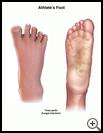
Athlete's Foot: Brief Version
What is athlete's foot?
Athlete's foot mainly occurs in teens and adults. It is rare in children under age 10. Athlete's foot is a fungus infection that causes a scaly, cracked rash between the toes. The rash usually:
- Itches and burns
- Becomes raw and oozes fluid when scratched
- Spreads to the instep
Athlete's foot is caused by a fungus that grows on warm, damp skin.
How can I take care of my child?
- Use antifungal cream.
Buy Tinactin, Micatin, or Lotrimin cream at your drugstore. Put the cream on and around the rash twice a day. Continue applying for several weeks, or for at least 7 days after the rash seems to be gone.
- Keep the area dry.
Athlete's foot improves much faster if the feet are kept dry. It helps to go barefoot or wear sandals or thongs as much as possible. Wear cotton socks because the cotton absorbs sweat and keeps the feet dry.
- Control foot odor.
The feet often stop smelling bad when the athlete's foot improves. Rinse the feet and change socks twice a day.
Can athlete's foot be spread to other people?
Athlete's foot is not easily passed from person to person but is thought to be spread by direct contact with contaminated surfaces such as locker room or bathroom floors. The fungus won't grow on dry, normal skin. Athlete’s foot can cause jock itch if a towel used to dry the feet is then used to dry the groin area.
Call your child's doctor during office hours if:
- It looks infected (yellow pus, spreading redness, red streaks).
- Your child is less than 10 years old.
- The athlete's foot is not improved in 1 week.
- It is not completely cured after using this treatment for 2 weeks.
- The feet are painful.
- You have other concerns or questions.
Last modified: 2009-06-22
Last reviewed: 2017-06-05

